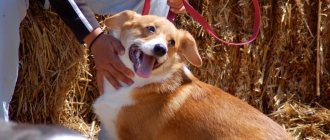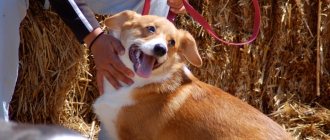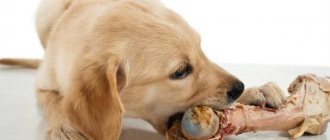Cough in our time, it would seem, has become a common occurrence, which will not surprise anyone. BUT! This is the case with humans, but if we talk about our smaller brothers, then the question is a little different. Of course, a dog can cough and this is natural for it, as for a living organism. But we are talking about a frequent moment that creates discomfort and interferes with the normal functioning of the body. If The dog is coughing a lot, as if he was choking, what does this mean? Every owner, willy-nilly, will pay attention to changes in the behavior of a pet.
If your dog starts coughing , you should think about possible diseases caused by irritants and other reasons. When wondering why a dog coughs, there are many determining factors to consider.
- Factors that are important to consider when your pet develops a cough
- characteristics of breed and age;
- duration of cough;
- in what manner does the cough manifest itself?
- does the appearance of cough depend on physical activity;
- the presence of simultaneous nasal discharge;
- general condition of the pet.
Having answered the above questions, you can consider the reasons for the appearance of this symptom .
Reasons why a dog coughs a lot, as if choking
Having noticed a coughing, grunting cough in a dog , you need to know the reasons. First of all, it should be said that many dog breeds, due to certain structural features of the skull, nasal septum and jaws, are more susceptible to diseases than other breeds. If your bulldog (this breed is one of the above) begins to cough frequently , this does not mean that this symptom is a feature of his breed. This means that he is more vulnerable to many diseases and needs more careful care and attention.
- Let's look at the others causes of coughin a dog:
- tonsillitis (inflammation of the tonsils in the oral cavity);
- oral infections (the gums are often affected by infection of wounded areas);
- dental diseases (caries, periodontal disease, pulpitis, periodontitis, polydontia);
- allergy;
- respiratory tract irritation;
- the dog is choking;
- tumors in the lungs;
- heart failure;
- adenovirus;
- parasitic infestation.
Let's look at the more common causes of cough in more detail:
1
Allergy.
If a dog coughs heavily, as if choking, grunts, chokes, without coughing up blood, this is most likely caused by various allergens.
For example - tobacco smoke, pollen, dust, household chemicals, flea products, medicines. 2 Mechanical damage and foreign bodies.
This reason is very common nowadays.
To recognize this cause, you need to determine the nature of the cough; there may be a foreign body in the throat, which can limit the movement of the neck and force you to stand in uncomfortable positions, more on this below. 3 Parasitic cough.
In this case, infection occurs when the animal swallows the parasite larvae.
The parasite enters the respiratory tract and begins to develop there. Interestingly, infection is possible even after a mosquito bite.
4
Heart diseases.
Occurs due to damage to the mitral valve.
Large breed dogs
are susceptible to dilated cardiomyopathy, which is also accompanied by a cough.
5 Oncological diseases.
In the case of various tumors in the lungs, which most often appear
in older dogs
, cancer develops.
They are also a cause of cough. 6 Viral cough.
The reason here is infection with the parasite Bordetella bronchiseptica, which is transmitted through interaction with other dogs. These are the causes of the most common phenomena associated with coughing in dogs.
How to find out the truth
Another possible way for veterinarians to make dishonest money is to conceal the diagnosis. Let's say a veterinarian discovers a malignant tumor in a cat. But if he says that the tumor is benign and treatable. A housewife who dotes on her pet will give money for already useless procedures, medications and surgical interventions.
The veterinarian may deliberately “downplay” the diagnosis in order to earn more money. If something doesn't add up, insist on clarification. There is no need to be intimidated by unfamiliar terms - take a short break and try to find information on the Internet.
You are free to leave (or threaten to do so) to another clinic at any time.
Make sure that the veterinary clinic is honest - get tested in an independent laboratory.
Justice
What to do if an animal was injured as a result of unprofessional actions of a veterinarian:
- Write an official complaint addressed to the head of the clinic.
- File a complaint with the city veterinary department.
- You can contact Rospotrebnadzor.
- Contact a lawyer for help
The Law “On the Protection of Consumer Rights” and Article 245 of the Criminal Code “Cruelty to Animals” are the grounds for considering claims regarding the work of veterinary clinics.
Symptoms when a dog coughs a lot, as if choking
Correctly understand the symptoms of the disease
- a very necessary, even necessary skill for the owner.
By correctly navigating the signs of the disease, it becomes possible to respond promptly and correctly to the presence of a cough in your pet. But do not forget that the owner’s reaction is only the primary action; only a qualified specialist should make a specific diagnosis and prescribe treatment
. Our cough;
Viral cough can affect all dogs, regardless of breed or age. The course of the disease can be either mild or severe. If you do not contact a veterinary center in time, there is a risk of complications leading to death.
Dog allergies:
- lacrimation;
- coughs constantly;
- redness of the eyes;
- the dog begins to groan, choke, cough;
- sneeze;
- blue gums;
- skin rashes;
- the dog grunts;
- the dog is choking.
An allergic cough in a dog can be seasonal and, as already mentioned, is mainly caused by an external irritant. It is useless to treat only cough with allergies separately; you need to eliminate the allergen itself
.
Parasitic cough:
- dry cough;
- worsening cough when lying down.
Unfortunately, this type of cough is very difficult to treat.
.It is difficult to eliminate the damage caused by the parasite while it is in the body. The most important rule here is timely prevention of this disease.
Heart disease in dogs:
- wheezing when breathing;
- coughing;
- the pet may bark for no reason;
- blue gums;
- decreased vital activity in the dog.
Oncological diseases:
The most important difference from all other symptoms in the presence of a tumor is shortness of breath, as well as a decrease in general activity.
Mechanical damage and foreign bodies:
- coughing attacks;
- complete refusal to eat and drink;
- suffocation;
- wheezing;
- blood impurities;
- the dog is choking.
If your pet has this problem, as in many other cases, do not delay contacting
to the veterinary clinic. All this is fraught with very serious consequences.
Treatment of expectorant cough in dogs
If the dog has a cough, as if it is choking, treatment is strictly under the supervision of a specialist. A critical situation requires a quick visit to the clinic. There the doctor will do everything necessary:
- The specialist will be able to remove the foreign object using thin and long tweezers and, if necessary, apply anesthesia.
- Bronchitis, tracheobronchitis or pneumonia require the prescription of anti-inflammatory drugs, a course of antibiotics, immune-supporting drugs and complete calm.
- Infection of the lungs with worms is diagnosed using tests. The doctor prescribes anthelmintics for a specific type of parasite.
- Heart failure, which is accompanied by wheezing sounds, is eliminated with sedatives and strengthening drugs. In addition, the doctor prescribes diuretics, special nutrition, and limited physical activity.
- Viral infections are treated with strong antibiotics, anti-inflammatory drugs and immunostimulants.
- Allergic reactions are controlled by the use of medications that relieve symptoms. A special diet and elimination of the allergen will completely help cure the disease.
If your pet chokes, seconds count. Therefore, the owner must provide first aid to the pet himself.
First aid if your dog is coughing a lot, as if he is choking
your dog bark hoarsely ? Are you starting to notice how she starts coughing and clearing her throat? How to treat a dog's cough ? What to do if you, as the owner of your pet, notice strange behavior in your animal, accompanied by wheezing, shortness of breath, and groaning. If the dog starts coughing . If a dog takes positions that are strange for it, cannot lie down calmly, or stretches its neck strangely, this is a reason to compare its actions with the symptoms described above and call a doctor . After which it is necessary to provide first aid to the dog , if the situation requires it, because there is a possibility that the veterinarian simply will not have time. Unfortunately, in the practice of helping pets, such situations also occur. Now we will look at what kind of help needs to be provided to the “patient” when a “dangerous” cough is detected in a dog in order to reduce the likelihood of bad consequences to zero. First of all
it is necessary to calm the animal, limit physical activity, and ensure a sufficient flow of oxygen.
You need to check for visible foreign bodies in the throat or mouth. Next, we measure
body temperature and determine the nature of the cough.
See if there is any bloody discharge from the nose. symptoms of Quincke's edema
on the face (swelling of the larynx, swelling of the muzzle), you must immediately take the animal to the veterinarian.
Quincke's edema is dangerous because it blocks breathing in a short period of time and is of an allergic nature. Under no circumstances should you self-medicate; it could cost your pet’s life! When talking about cough, you should treat it with extreme caution and seriousness, because we are talking about respiratory diseases. The lungs supply the body with oxygen, which is necessary for life. Impaired respiratory function is unacceptable. Treatment of cough in dogs is a matter for specialists; do not trust their health to suspicious individuals.
Actions in case of suffocation
If the animal is choking and suffocating, the dog owner must use one of the special techniques. You also need to know the list of prohibited actions:
- Don't hit your dog on the back. This is an ineffective and dangerous method, due to which the choking object may fall deeper into the trachea, which will aggravate the situation. Animals of small breeds should not be hit on the back, because the thin spine is very easy to damage.
- Do not pour vegetable oil down your throat. It will not help the foreign object slip out, and the owner will lose valuable time saving the pet.
The main thing is not to panic, not to scream. This will worry the pet even more: it may not give in to help. You need to calm down, gently but firmly take your pet and take actions to help save his life:
- Use the gravity of the earth. The four-legged friend must be taken by the hind limbs and lifted slightly. Small rocks can even be lifted off the ground by holding them head down. To avoid damaging the spine, you should hold the dog by the neck. A large or medium-sized dog only needs to be lifted slightly. The foreign object should fall out of the throat on its own - if it does not sink deeply.
- The Heimlich maneuver, used for humans and animals. The pet is grabbed from the back at the waist. Then they find the place where the ribs end and the stomach is located. A folded fist is placed there, another hand is placed on top, then rhythmically squeezed upward. Due to the contraction of the esophagus and trachea, the object will pop out. Don't press too hard to avoid breaking the ribs. You need to be extremely careful with small breeds.
- Removing a foreign object manually. The dog's mouth is opened, it is firmly fixed and, illuminated with a flashlight, a foreign body is discovered. The next step is to remove it with tweezers or your fingers. The main task is not to injure the mucous membrane of the throat or palate.
If the dog has lost consciousness, resuscitation measures are carried out. They involve pressing on the chest in a certain rhythm: 15 rhythms per 1 breath. The rescued and calmed pet is taken to the veterinarian. Knowing first aid techniques can help save your pet's life.
Heart diseases
A cough can indicate not only respiratory diseases, but also a canine heart disease. In addition to coughing, symptoms such as:
- labored breathing;
- weakness, drowsiness;
- lack of appetite;
- blue discoloration of mucous membranes;
- open mouth when breathing, as if the animal does not have enough air coming through the nose. This happens especially often in hot weather;
- The cough most often occurs at night or in the morning.
In order to make an accurate diagnosis, you need to go to a veterinary clinic. After the examination, the veterinarian will prescribe medications to normalize heart function, to maintain uniform breathing, and will tell you what to give and what to do if an attack occurs. If heart disease is accompanied by edema, then diuretics are prescribed.
Diagnostics
Before examining your dog, factors that may be causing the panting, such as heatstroke, overexertion, or stress, should be considered and removed. If, after eliminating the above reasons, breathing problems remain, you should contact your veterinarian and conduct additional research.
• A complete blood count, blood chemistry panel, and urinalysis are an important part of any initial workup and help identify conditions such as anemia, infections, or diabetes. • X-ray of the chest and abdominal cavities. Performed to identify a foreign body or tumor in the upper respiratory tract.
• Tests to assess acid-base balance. • Echocardiography (ultrasound of the heart) and chest ultrasound may be helpful in some cases. • An abdominal ultrasound may be done to look for fluids or tumors.
• Endocrine testing to detect hyperadrenocorticism and hypothyroidism. • Blood test for acetylcholine receptor antibodies • Heartworm test. • Thoracentesis (analysis of fluid, air, or tissue from the chest) and fluid analysis, cytology.
• Bronchoscopy, computed tomography (CT), magnetic resonance imaging (MRI) and pulmonary scintigraphy.
[custom_ads_shortcode2]
Paroxysmal breathing
Paroxysmal breathing, or reverse sneezing, is not a disease. This is a condition when, under the influence of certain factors, the respiratory process is disrupted and air is drawn in instead of exhaled. This most often occurs in small breeds. Outwardly, it looks as if the pet is suffocating, the neck is stretched, the eyes seem bulging, and the paws are spread wide apart.
Such breathing may be accompanied by vomiting, convulsions of the soft palate and throat. The danger is that at such a moment, vomit can enter the lungs and cause aspiration pneumonia, which is life-threatening.
The cause may be sudden inhalation of cold or hot air, or air polluted by exhaust gases or cigarette smoke.
Treatment for this condition is not required; it is necessary to eliminate the causes and prevent them in the future.
Tracheal collapse
Collapse is a chronic disease that initially occurs unnoticed and progresses over time. It can be either congenital or acquired, and is more common in small dogs. Characterized by the following symptoms:
- occasional cough that sounds like quacking;
- loss of appetite;
- gagging when eating or drinking;
- weakness;
- dyspnea.
The disease is well treated only at the initial stage. Appropriate medications are used and special dietary supplements are prescribed to promote the restoration of cartilage tissue. If the disease is advanced, then only surgery can help. Damaged rings in the trachea are replaced with implants.
Treatment in clinical and home conditions: features and recommendations
Firstly, you must immediately decide on one important nuance: in case of more or less serious diseases of the respiratory system, we would strongly advise against resorting to “self-medication”. So in cases where the question arises about which conditions for therapy to choose, i.e. treatment in clinical and home conditions, you should always prefer a professional clinic. There is very little you can do at home:
- In mild cases, expectorants, anti-inflammatory drugs, antibiotics and other antimicrobial drugs, anthelmintics, etc. are given.
- Sometimes the owner himself can give an asthmatic dog inhalation, but nothing more.
Clinical treatment directly depends on the type of pathology, and we have already written about many aspects above:
- In oncology, if there is at least some possibility of removing the tumor, surgery is required. Otherwise, intensive chemotherapy and radiotherapy.
- For asthma, antispasmodics, antihistamines and other specific medications are used.
- The most difficult thing is with tracheal collapse. In the first two stages, you can still get by with antitussive medications and anti-inflammatory corticosteroids, but as the disease progresses, they all become completely meaningless. The only solution is an expensive operation, during which the veterinarian will install implants, strengthening the animal’s “native” trachea.
- In case of “harmless” parasitic infestations (more precisely, in advanced cases), it is sometimes necessary to resort to surgery. There are cases when a dog’s lungs are literally “exhausted” by numerous parasite larvae, and only a timely operation can save the life (and even partially the health) of the dog.
- For pneumonia and bronchitis, the pet is prescribed a course of powerful broad-spectrum antibiotics, droppers, anti-inflammatory corticosteroids, etc. are indicated.
Finally, I would like to warn breeders that timely contact with a veterinarian plays a huge role.
If the dog can no longer breathe and instead of lungs he has a couple of “bags” of pus, then even the best clinic cannot help him. In cases where the owner turned to specialists on time, there is every chance of getting by with little bloodshed. This way the dog will be healthier, and the funds for his treatment will be spent an order of magnitude less.











